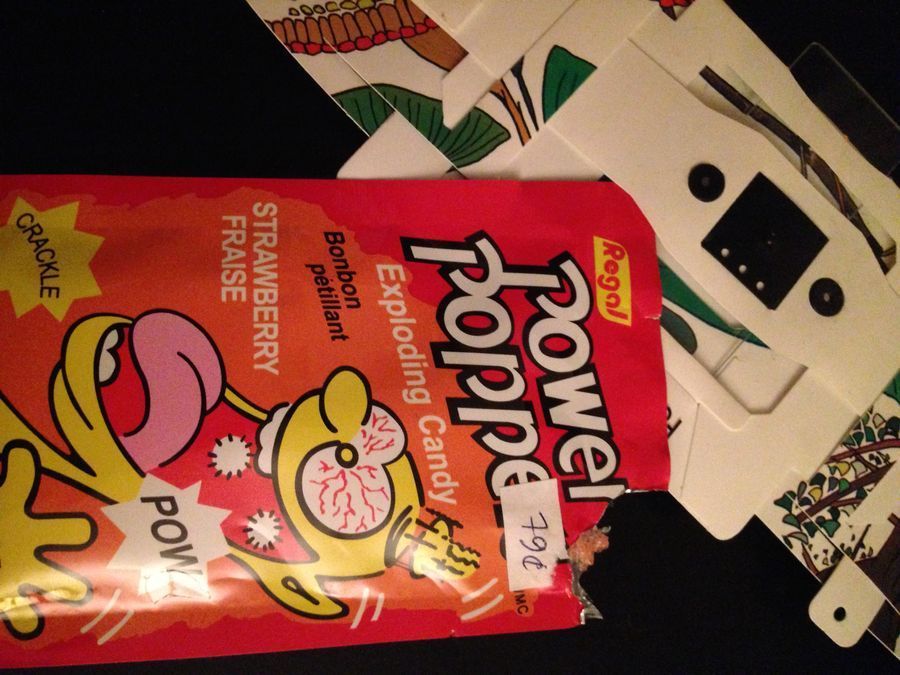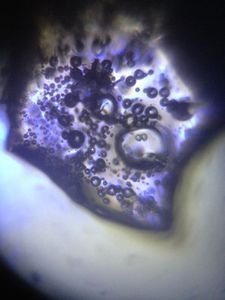How does a pop-rock candy pop?
 Dec 25, 2014 • 10:14 AM UTC
Dec 25, 2014 • 10:14 AM UTC Canada
Canada 140x Magnification
140x Magnification Non-Living
Non-Living
Manu Prakash
I am a faculty at Stanford and run the Prakash Lab at Department of Bioengineering at Stanford University. Foldscope community is at the heart of our Frugal Science movement - and I can not tell you how proud I am of this community and grassroots movement. Find our work here: http://prakashlab.stanford.edu
266posts
1192comments
42locations

The first time I had a pop-rock candy, it was like “little explosions” in my mouth. I had always wondered what on earth would make that happen. This Christmas, I finally found them in a candy store and here is the result of exploring pop-rock candy with my Foldscope.


Methods:
1. Because I wanted to see the effect of water/saliva on pop-rock candy, I took data with the dry candy rock and added water.
2. I also collected high-speed videos with iPhone6 for the first time – that was a lot of fun.
3. I collected the popping audio sounds using the mics on the iphone, and was able to plot them using matplotlib.
4. I used iMovie to make a quick video with the micro-explosions synchronized with the audio track.
Watch the video for some explanation of the process:
1. Because I wanted to see the effect of water/saliva on pop-rock candy, I took data with the dry candy rock and added water.
2. I also collected high-speed videos with iPhone6 for the first time – that was a lot of fun.
3. I collected the popping audio sounds using the mics on the iphone, and was able to plot them using matplotlib.
4. I used iMovie to make a quick video with the micro-explosions synchronized with the audio track.
Watch the video for some explanation of the process:
Observations:
1.From the sound track, it’s clear you hear on average ~10 explosions per second. That’s a lot of bubbles popping. Individual explosions only last a few milli-seconds.
2. The explosion is able to displace a highly viscous sugar solution (akin to molasses). That would require a lot of punch packed in a single explosion.
3. We know the gas in the bubble is carbon dioxide (from the wrapping paper).
I wonder if we could predict the actual pressure inside each one of the bubbles embedded in rock-candy. Since they are processed with high-pressure gas, the bubble curvature is not enough to predict the pressure. But if we are to watch the dynamics of a popping bubble (that is speed of expansion of the bubble wall); we should be able to predict the pressure inside the bubble (assuming a known viscosity of sugar solution). Even the 240fps high-speed camera was not good enough to actually catch the dynamics of the explosion (the bubbles popped in less than one or two frames). That would mean the action takes place in less than ~4 milli-second (where milli-second is one-thousand’s of a second).
Next, I am also wondering how to harness this stored energy – something like a mechanical battery. This energy of high-pressure gas can remain stored for millions of years (if the rock-candy stays dry) locked inside a crystal of sugar. And releases at a moments notice. Now I just need to figure out how to make something useful out of it. I am working on that – with my first target being a toy boat that works on rock-candy as fuel. Now that would be fun!!!
Note: I am still looking for a way to get the exact timing out of the high-speed videos collected from the iPhone, so I can quantify the exact time of the micro-explosion. Please post a comment if you know how to do the same.
1.From the sound track, it’s clear you hear on average ~10 explosions per second. That’s a lot of bubbles popping. Individual explosions only last a few milli-seconds.
2. The explosion is able to displace a highly viscous sugar solution (akin to molasses). That would require a lot of punch packed in a single explosion.
3. We know the gas in the bubble is carbon dioxide (from the wrapping paper).
I wonder if we could predict the actual pressure inside each one of the bubbles embedded in rock-candy. Since they are processed with high-pressure gas, the bubble curvature is not enough to predict the pressure. But if we are to watch the dynamics of a popping bubble (that is speed of expansion of the bubble wall); we should be able to predict the pressure inside the bubble (assuming a known viscosity of sugar solution). Even the 240fps high-speed camera was not good enough to actually catch the dynamics of the explosion (the bubbles popped in less than one or two frames). That would mean the action takes place in less than ~4 milli-second (where milli-second is one-thousand’s of a second).
Next, I am also wondering how to harness this stored energy – something like a mechanical battery. This energy of high-pressure gas can remain stored for millions of years (if the rock-candy stays dry) locked inside a crystal of sugar. And releases at a moments notice. Now I just need to figure out how to make something useful out of it. I am working on that – with my first target being a toy boat that works on rock-candy as fuel. Now that would be fun!!!
Note: I am still looking for a way to get the exact timing out of the high-speed videos collected from the iPhone, so I can quantify the exact time of the micro-explosion. Please post a comment if you know how to do the same.
Sign in to commentNobody has commented yet... Share your thoughts with the author and start the discussion!

 0 Applause
0 Applause 0 Comments
0 Comments
















